Small overlap front: driver-side
Rating applies to 2017-20 models
Tested vehicle: 2017 Kia Cadenza Premium 4-door
The Kia Cadenza was redesigned for the 2017 model year.
| Evaluation criteria | Rating |
|---|---|
| Structure and safety cage | |
| Driver injury measures | |
| Head/neck | |
| Chest | |
| Hip/thigh | |
| Lower leg/foot | |
| Driver restraints and dummy kinematics | |
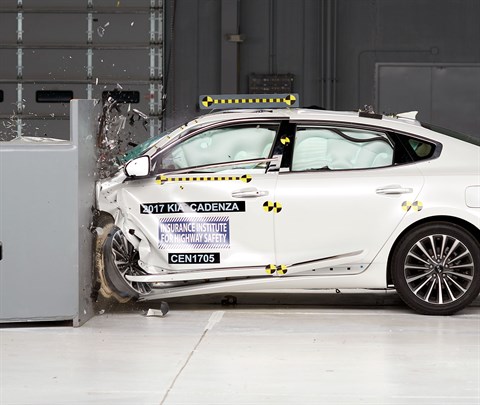
Action shot taken during the driver-side small overlap frontal crash test.
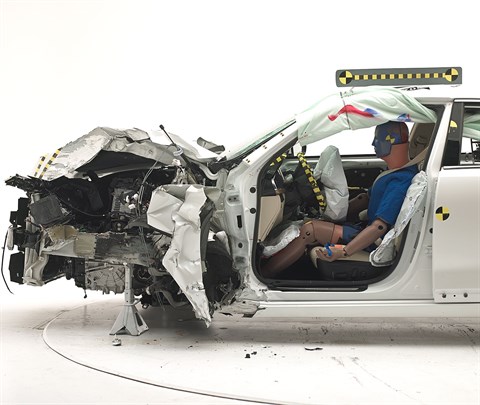
The dummy's position in relation to the door frame, steering wheel, and instrument panel after the crash test indicates that the driver's survival space was maintained well.
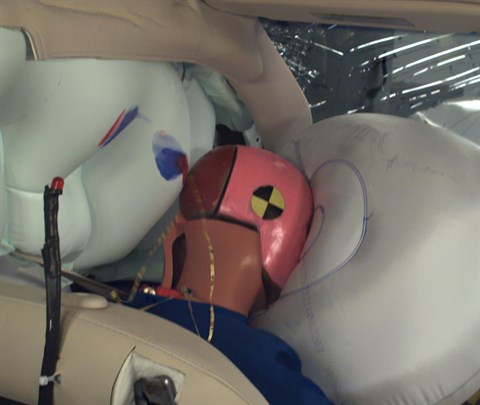
The frontal and side curtain airbags worked well together to keep the head from coming close to any stiff structure or outside objects that could cause injury.
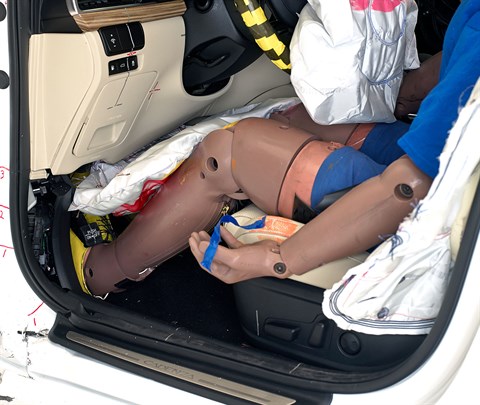
The driver's space was maintained well, and risk of injuries to the dummy's legs and feet was low.
Measures of occupant compartment intrusion on driver side
| Evaluation criteria | Measurement |
|---|---|
| Test ID | CEN1705 |
| Lower occupant compartment | |
| Lower hinge pillar max (cm) | 4 |
| Footrest (cm) | 5 |
| Left toepan (cm) | 3 |
| Brake pedal (cm) | 3 |
| Parking brake (cm) | 10 |
| Rocker panel lateral average (cm) | 1 |
| Upper occupant compartment | |
| Steering column | 0 |
| Upper hinge pillar max (cm) | 4 |
| Upper dash (cm) | 4 |
| Lower instrument panel (cm) | 4 |
Driver injury measures
| Evaluation criteria | Measurement |
|---|---|
| Test ID | CEN1705 |
| Head | |
| HIC-15 | 146 |
| Peak gs at hard contact | no contact |
| Neck | |
| Tension (kN) | 0.9 |
| Extension bending moment (Nm) | 9 |
| Maximum Nij | 0.22 |
| Chest maximum compression (mm) | 23 |
| Femur (kN) | |
| Left | 0.5 |
| Right | 0.4 |
| Knee displacement (mm) | |
| Left | 3 |
| Right | 2 |
| Knee-thigh-hip injury risk (%) | |
| Left | 0 |
| Right | 0 |
| Maximum tibia index | |
| Left | 0.51 |
| Right | 0.33 |
| Tibia axial force (kN) | |
| Left | 2.4 |
| Right | 0.9 |
| Foot acceleration (g) | |
| Left | 73 |
| Right | 65 |
Small overlap front: passenger-side
Rating applies to 2017-20 models
Tested vehicle: 2017 Kia Cadenza Premium 4-door
The Kia Cadenza was redesigned for the 2017 model year. Passenger-side small overlap frontal ratings are assigned by the Institute based on a test conducted by Hyundai/Kia.
| Evaluation criteria | Rating |
|---|---|
| Overall evaluation | |
| Structure and safety cage | |
| Passenger injury measures | |
| Head/neck | |
| Chest | |
| Hip/thigh | |
| Lower leg/foot | |
| Passenger restraints and dummy kinematics | |
| Driver injury measures | |
| Head/neck | |
| Chest | |
| Hip/thigh | |
| Lower leg/foot | |
| Driver restraints and dummy kinematics | |
Measures of occupant compartment intrusion on passenger side
| Evaluation criteria | Measurement |
|---|---|
| Test ID | VTP1709 |
| Lower occupant compartment | |
| Lower hinge pillar max (cm) | 6 |
| Footrest (cm) | 9 |
| Right toepan (cm) | 4 |
| Center toepan (cm) | 1 |
| Rocker panel lateral average (cm) | 2 |
| Upper occupant compartment | |
| Center dash (cm) | 6 |
| Upper hinge pillar max (cm) | 4 |
| Upper dash (cm) | 10 |
| Right lower dash (cm) | 9 |
Passenger injury measures
| Evaluation criteria | Measurement |
|---|---|
| Test ID | VTP1709 |
| Head | |
| HIC-15 | 97 |
| Peak gs at hard contact | no contact |
| Neck | |
| Tension (kN) | 0.8 |
| Extension bending moment (Nm) | 6 |
| Maximum Nij | 0.13 |
| Chest maximum compression (mm) | 19 |
| Femur (kN) | |
| Left | 0.2 |
| Right | 0.2 |
| Knee displacement (mm) | |
| Left | 0 |
| Right | 1 |
| Knee-thigh-hip injury risk (%) | |
| Left | 0 |
| Right | 0 |
| Maximum tibia index | |
| Left | 0.35 |
| Right | 0.46 |
| Tibia axial force (kN) | |
| Left | 1.5 |
| Right | 1.1 |
| Foot acceleration (g) | |
| Left | 55 |
| Right | 54 |
Driver injury measures
| Evaluation criteria | Measurement |
|---|---|
| Test ID | VTP1709 |
| Head | |
| HIC-15 | 68 |
| Peak gs at hard contact | no contact |
| Neck | |
| Tension (kN) | 0.7 |
| Extension bending moment (Nm) | 22 |
| Maximum Nij | 0.27 |
| Chest maximum compression (mm) | 27 |
| Femur (kN) | |
| Left | 0.2 |
| Right | 0.2 |
| Knee displacement (mm) | |
| Left | 0 |
| Right | 1 |
| Knee-thigh-hip injury risk (%) | |
| Left | 0 |
| Right | 0 |
| Maximum tibia index | |
| Left | 0.30 |
| Right | 0.22 |
| Tibia axial force (kN) | |
| Left | 0.5 |
| Right | 0.8 |
| Foot acceleration (g) | |
| Left | 26 |
| Right | 35 |
Moderate overlap front: original test
Rating applies to 2017-20 models
Tested vehicle: 2017 Kia Cadenza Premium 4-door
The Kia Cadenza was redesigned for the 2017 model year. Moderate overlap frontal ratings are assigned by the Institute based on a test conducted by Hyundai/Kia.
| Evaluation criteria | Rating |
|---|---|
| Overall evaluation | |
| Structure and safety cage | |
| Driver injury measures | |
| Head/neck | |
| Chest | |
| Leg/foot, left | |
| Leg/foot, right | |
| Driver restraints and dummy kinematics | |
Measures of occupant compartment intrusion on driver side
| Evaluation criteria | Measurement |
|---|---|
| Test ID | VTF1701 |
| Footwell intrusion | |
| Footrest (cm) | 5 |
| Left (cm) | 10 |
| Center (cm) | 8 |
| Right (cm) | 6 |
| Brake pedal (cm) | 5 |
| Instrument panel rearward movement | |
| Left (cm) | 0 |
| Right (cm) | 2 |
| Steering column movement | |
| Upward (cm) | -3 |
| Rearward (cm) | 5 |
| A-pillar rearward movement (cm) | 0 |
Driver injury measures
| Evaluation criteria | Measurement |
|---|---|
| Test ID | VTF1701 |
| Head | |
| HIC-15 | 183 |
| Peak gs at hard contact | no contact |
| Neck | |
| Tension (kN) | 0.1 |
| Extension bending moment (Nm) | 15 |
| Maximum Nij | 0.25 |
| Chest maximum compression (mm) | 31 |
| Legs | |
| Femur force - left (kN) | 1.1 |
| Femur force - right (kN) | 0.9 |
| Knee displacement - left (mm) | 1 |
| Knee displacement - right (mm) | 1 |
| Maximum tibia index - left | 0.50 |
| Maximum tibia index - right | 0.31 |
| Tibia axial force - left (kN) | 1.3 |
| Tibia axial force - right (kN) | 2.1 |
| Foot acceleration (g) | |
| Left | 77 |
| Right | 61 |
Side: original test
Rating applies to 2017-20 models
Tested vehicle: 2017 Kia Cadenza Premium 4-door
The Kia Cadenza was redesigned for the 2017 model year. Two side tests of the Cadenza were conducted, one by the Institute and the other by Hyundai/Kia. Ratings are based on both tests.
| Evaluation criteria | Rating |
|---|---|
| Overall evaluation | |
| Structure and safety cage | |
| Driver injury measures | |
| Head/neck | |
| Torso | |
| Pelvis/leg | |
| Driver head protection | |
| Rear passenger injury measures | |
| Head/neck | |
| Torso | |
| Pelvis/leg | |
| Rear passenger head protection | |
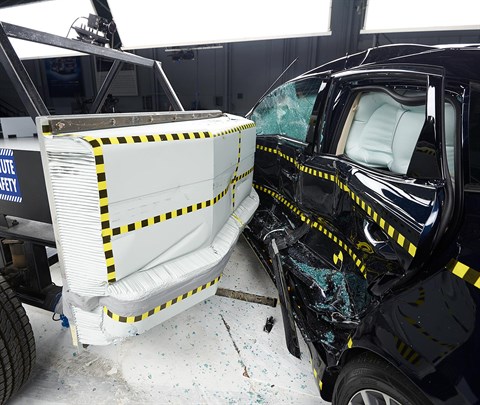
View of the vehicle and barrier just after the Institute's crash test.
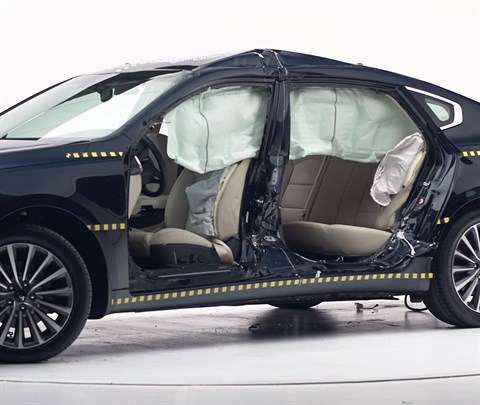
View of the vehicle after the crash with doors removed, showing the side airbags and damage to the occupant compartment (Institute test car shown).
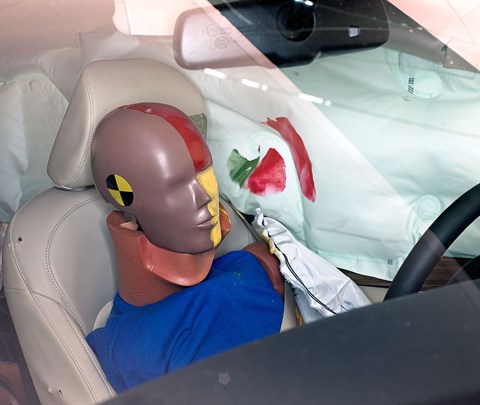
Smeared greasepaint shows where the driver dummy's head was protected from being hit by hard structures by the side airbags in the Institute's test.
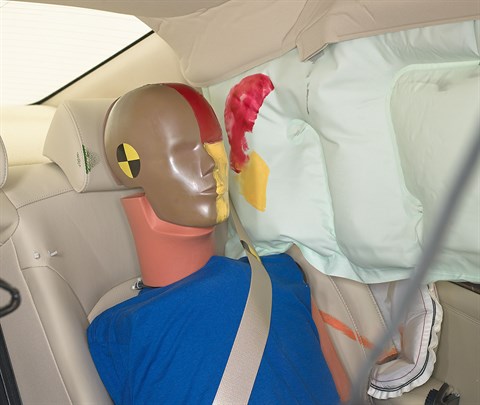
Smeared greasepaint shows where the rear passenger dummy’s head was protected by the side curtain airbag.
Measures of occupant compartment intrusion on driver side
| Test ID | VTS1701 | CES1704 |
|---|---|---|
| B-pillar to longitudinal centerline of driver's seat (cm) | -16.5 | -16.0 |
| Negative numbers indicate the amount by which the crush stopped short of the seat centerline. | ||
Driver injury measures
| Evaluation criteria | Measurement | |
|---|---|---|
| Test ID | VTS1701 | CES1704 |
| Head HIC-15 | 266 | 306 |
| Neck | ||
| Tension (kN) | 0.3 | 1.1 |
| Compression (kN) | 0.9 | 0.4 |
| Shoulder | ||
| Lateral deflection (mm) | 31 | 41 |
| Lateral force (kN) | 1.3 | 1.4 |
| Torso | ||
| Maximum deflection (mm) | 32 | 40 |
| Average deflection (mm) | 28 | 34 |
| Maximum deflection rate (m/s) | 4.20 | 4.53 |
| Maximum viscous criterion (m/s) | 0.43 | 0.58 |
| Pelvis | ||
| Iliac force (kN) | 1.7 | 1.8 |
| Acetabulum force (kN) | 1.8 | 1.7 |
| Combined force (kN) | 3.5 | 3.4 |
| Left femur | ||
| L-M force (kN) | 0.9 | 0.7 |
| L-M moment (Nm) | 205 | 187 |
| A-P moment (Nm) | -18 | 45 |
Passenger injury measures
| Evaluation criteria | Measurement | |
|---|---|---|
| Test ID | VTS1701 | CES1704 |
| Head HIC-15 | 85 | 67 |
| Neck | ||
| Tension (kN) | 0.5 | 0.2 |
| Compression (kN) | 0.3 | 0.4 |
| Shoulder | ||
| Lateral deflection (mm) | 10 | 13 |
| Lateral force (kN) | 0.7 | 0.8 |
| Torso | ||
| Maximum deflection (mm) | 15 | 16 |
| Average deflection (mm) | 12 | 13 |
| Maximum deflection rate (m/s) | 2.44 | 2.08 |
| Maximum viscous criterion (m/s) | 0.15 | 0.13 |
| Pelvis | ||
| Iliac force (kN) | 0.4 | 0.3 |
| Acetabulum force (kN) | 2.3 | 0.0 |
| Combined force (kN) | 2.5 | 0.0 |
| Left femur | ||
| L-M force (kN) | 0.4 | 0.6 |
| L-M moment (Nm) | 44 | 92 |
| A-P moment (Nm) | 41 | -39 |
Roof strength
Rating applies to 2017-20 models
Tested vehicle: 2017 Kia Cadenza Technology 4-door
| Overall evaluation | |
|---|---|
| Curb weight | 3,727 lbs |
| Peak force | 16,840 lbs |
| Strength-to-weight ratio | 4.52 |
Head restraints & seats
Seat type: Power leather seat
| Overall evaluation | |
|---|---|
| Dynamic rating | |
| Seat/head restraint geometry |
| Seat type | Power leather seat |
|---|---|
| Geometry | |
| Backset (mm) | 34 |
| Distance below top of head (mm) | 0 |
| Seat design parameters | |
| Pass/fail | Pass |
| Max T1 acceleration (g) | 12.9 |
| Head contact time (ms) | 57 |
| Force rating | 1 |
| Neck forces | |
| Max neck shear force (N) | 0 |
| Max neck tension (N) | 551 |
About the head restraint & seat test
Currently, IIHS tests apply only to front seats.
Front crash prevention: vehicle-to-vehicle
Front crash prevention: pedestrian (day)
Child seat anchors
Rating applies to 2017-20 models
| Evaluation criteria | Rating |
|---|---|
| Overall evaluation | |
| Vehicle trim | Premium |
| Seat type | leather |
This vehicle has 2 rear seating positions with complete child seat attachment (LATCH) hardware.
It has 1 additional seating position with a tether anchor only.
| Evaluation criteria | Rating |
|---|---|
| Overall evaluation | |
| Vehicle trim | Premium |
| Seat type | leather |
| Rating icon | Rating |
|---|---|
| G | Good |
| A | Acceptable |
| M | Marginal |
| P | Poor |
| Seating positions that rely on borrowed lower anchors or have only a tether anchor available are not rated. | |
thether anchor symbol | Tether anchor |
lower anchor symbol | Lower anchors |
| Lower anchor(s) can be borrowed from adjacent positions(s) | |
| No hardware available |
Details by seating position
| Position | Rating |
|---|---|
| 1 | |
| Tether anchor | |
| easy-to-find location | |
| no other hardware could be confused for anchor | |
| Lower anchors | |
| too deep in seat | |
| not too much force needed to attach | |
| difficult to maneuver around anchors | |
| 2 | |
| Tether anchor | |
| easy-to-find location | |
| no other hardware could be confused for anchor | |
| Lower anchors | |
| none available | |
| 3 | |
| Tether anchor | |
| easy-to-find location | |
| no other hardware could be confused for anchor | |
| Lower anchors | |
| too deep in seat | |
| not too much force needed to attach | |
| difficult to maneuver around anchors |
Seat position 21
| Lower anchor A | |
|---|---|
| Open access rated | No |
| Depth (cm) | 4-6 |
| Force (lbs) | 8 |
| Clearance angle (degrees) | 41 |
| Lower anchor B | |
| Open access rated | No |
| Depth (cm) | 4-6 |
| Force (lbs) | 7 |
| Clearance angle (degrees) | 48 |
| Tether anchor | |
| Location | Rear deck |
| Confusing hardware present | No |
| Has contrasting label within 3 inches of tether anchor |
No |
| Tether anchors can be accessed while seatback is properly positioned for use of LATCH |
Not measured |
Seat position 22
| Lower anchor A | |
|---|---|
| No lower latch for this seat position | |
| Lower anchor B | |
| No lower latch for this seat position | |
| Tether anchor | |
| Location | Rear deck |
| Confusing hardware present | No |
| Has contrasting label within 3 inches of tether anchor |
No |
| Tether anchors can be accessed while seatback is properly positioned for use of LATCH |
Not measured |
Seat position 23
| Lower anchor A | |
|---|---|
| Open access rated | No |
| Depth (cm) | 4-6 |
| Force (lbs) | 10 |
| Clearance angle (degrees) | 41 |
| Lower anchor B | |
| Open access rated | No |
| Depth (cm) | 4-6 |
| Force (lbs) | 16 |
| Clearance angle (degrees) | 41 |
| Tether anchor | |
| Location | Rear deck |
| Confusing hardware present | No |
| Has contrasting label within 3 inches of tether anchor |
No |
| Tether anchors can be accessed while seatback is properly positioned for use of LATCH |
Not measured |
